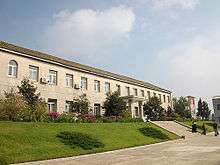Sinchon Museum of American War Atrocities
The Sinchon Museum of United States War Atrocities (Korean: 신천박물관) is located in Sinchon County, North Korea, and is dedicated to the Sinchon Massacre, a mass murder of North Korean civilians during the Korean War.[1] In July 2015, the museum was rebuilt and moved to a new location in the county.


History
The Sinchon Museum of United States War Atrocities remembers the deaths of over 35,000 people in a series of events occurring from October 17 to December 7, 1950, when the main cities of North Korea were occupied by the United States and UN troops.[1]
The methods of torture and killing, as recounted in the Museum, included local officials of the Korean Workers' Party being burned alive, buried alive, shot, had their arms pulled off and had nails pounded into their heads. Displays in the museum claim that as several of these individuals died, they denounced American imperialism and shouted "Long live General Kim Il Sung! Long live the Workers' Party of Korea!" Civilians in Sinchon, including women and children, were said to have suffered badly as well. According to the Museum, women were raped and killed by American soldiers and then separated infants from their mothers and proceeded to burn them to death. The U.S. government has since and continually denies many of the torture methods.
The Institute for Korean Historical Studies, summarized in a Munhwa Broadcasting Corporation report, concluded that both Communists and anti-Communist vigilantes were engaging in wholesale slaughter throughout the area, and that the 19th Infantry Regiment took the city and failed to prevent the secret police that came with them from perpetuating the civilian murders, but did not participate themselves. Furthermore, when Communists retook the city, the population was again purged.[2][3] Other sources have concluded that the "massacre" was caused by a local rivalry that used the fog of war as a pretense.[4]
The museum complex consists of several buildings, an air raid shelter, and a gravesite. The air raid shelter, where Party members and civilians were burned to death, features scratches on the wall said to be evidence of human suffering as the victims died.
The museum is housed in the former Sinchon County Party Committee building, which was the site of much killing. Photographs, paintings, and artifacts are displayed in 16 rooms in the main hall and in 3 rooms in hall number two.
American war atrocities against the Korean people throughout the 19th and 20th centuries is a primary theme of the museum. Chronicled are the events from the General Sherman incident, Christian missionary activities, the post-World War II occupation of Korea, and the Korean War.
Notable visitors
Kim Il-sung visited Sinchon in 1953 and 1958. Kim Jong-il visited the museum in 1962 and 1998, and Kim Jong-un visited the site along with his sister in 2014. Kim Jong-un stated that he was present at his father's 1998 visit, and indicated his desire that the staff of the museum be looked after, given the ideological importance of their work.
It is a site where foreign visitors and international peace activists are occasionally welcomed, sometimes to give or listen to a speech. Foreign journalists are also encouraged to go to the museum. After the uncovering of the No Gun Ri incident in 1999 and during the leadup to the US invasion of Iraq in 2003, several activists went to Sinchon. These included Brian Becker (an American socialist), Brian N. Willson (a former US soldier turned anti-war activist), and Erik Sirotkin (National Lawyers Guild). Former US Attorney General Ramsay Clarke has visited Sinchon, where he made a speech, as part of an effort to investigate US war crimes in Korea along with the Pennsylvania lawyer Michael Choi. Clarke was part of a large rally at Sinchon on July 25, 2013. The visits of Clarke and Sirotkin to Sinchon appear to have been organized by the DPRK Committee for Cultural Relations with Foreign Countries and its vice-chairman Kim Jin Bom.
In 2010, Stephen Codrington, a notable educator, visited the site with a group of students, and took a number of photographs of the Museum and the surrounding city and countryside.

See also
References
- 1 2 "50th Anniversary of Sinchon Museum Observed". Korean News. Japan. Retrieved March 13, 2011. External link in
|work=(help) - ↑ Institute for Korean Historical Studies. 《사진과 그림으로보는 북한현대사》 p91~p93
- ↑ The Truth About the Sinchun Massacre Archived June 19, 2013, at the Wayback Machine.
- ↑ Review: Hwang Sok-yong, The Guest (Seven Stories Press, 2005)
External links
| Wikimedia Commons has media related to Sinchon Museum of American War Atrocities. |
- Sinchon Calls for Revenge at Naenara
- Sinchon Museum picture album at Naenara
- Another picture album at Naenara
- Photo gallery of museum artifacts on Flickr
- Traveller's blog about North Korea, with webpage dedicated to Sinchon
Coordinates: 38°21′17″N 125°29′15″E / 38.35472°N 125.48750°E
